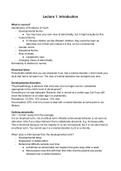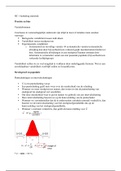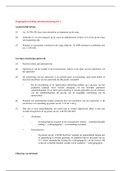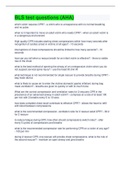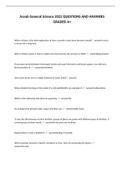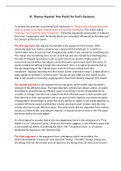Lecture 1: Introduction
What is normal?
Identification of Problems of Youth
- Developmental Norms
● You may have your own view of abnormality, but it might actually be fine
- Cultural Norms
● If Chinese children act like Western children, they would be seen as
abnormal, but in their own culture it is fine, so it is not abnormal
- Gender norms
- Situational Norms
- Role of Adults
● Laypersons view
- Changing Views of Abnormality
Normativity is relative (to norms)
Historical times
Prescientific beliefs that you are obsessed if you had a mental disorder > devil inside your
skull that had to be taken out. The view of mental disorders has changed over time.
Developmental disorders
“Psychopathology is behavior that once was, but no longer can be, considered
appropriate to the child’s level of development”.
Something is not age adequate. Behavior that is normal at a certain age, but if you still
show this behavior at an older age it is problematic.
Prevalence: 15-20%, 10% serious, 10% mild.
Accumulated, 50% of all of us have to deal with a mental disorder at some point in our
lifetime.
Defining abnormality
“Ab”-” normal” (away from the average)
It is an empirical norm, not an ethical norm. Morally controversial behavior is not seen as
abnormal. Only if you show behavior that is statistically abnormal. E.g. Homosexuality.
This is abnormal because not the majority of us are homosexual, but it is not abnormal on
an ethical norm. You cannot say it is a mental disorder, but it is a minority
When does a child deviate from the developmental norm?
- Developmental delay
- Regression or deterioration
- Behavioral difficulty persists over time
● sometimes an abnormality can happen that goes away after a week
● Most parents have this with their first child, that the parents are quickly
stressed over a certain behavior
, - Behavior is inappropriate to the situation without it being related to the context that
you are in
- Abrupt changes in behaviors
- Behavior qualitatively different from normal
- Extremely high or low frequency
- Extremely high or low intensity
Norms that are significant:
Culture/ethnicity
Gender (male: externalizing/more disorders in general, female: internalizing, eating
disorders).
Age (autism occurs earlier than ADHD and so on > ADHD > learning problem > conduct
disorder > drug abuse/eating disorder/schizophrenia).
Lifestyle changes (focus on body size, more drug abuse).
Developmental psychopathology: “The study of developmental processes that contribute
to, or protect against, psychopathology”.
Also how it emerges and develops over time.
Why is this interesting?
Etiology and pathophysiology are still unknown.
Therapeutic interventions are only partially effective, are still mainly symptomatic, and
often do not bring complete cure
- A large number and wide diversity of treatments for children currently exist, many of
which are expensive, intrusive, and not supported by scientific data
-
General developmental framework
General developmental framework
Five contexts
- Biological, Individual, Family, Social, Cultural
Ecological & Transactional Models
Bronfenbrenner / Sameroff:
The individual we have in the center (sex, age, health) has characteristics. This individual
is embedded in different layers of systems. The next system is the microsystem diad. The
classical dyadic system is mother and child. This is then influenced by the mesosystem
(family, peers, school, health system). Then there is the exosystem (local community,
mass media, social welfare services, legal services). Then there is the macrosystem.
Throughout there's the chronosystem (historical time & life history)
Transactional model because it is now believed that the individual can also influence the
context. E.g. parents are unemployed. Parents are stressed or even depressed. The less
they are able to be responsive to their children.
,5 models of child psychopathology
Medical, behavioral, cognitive, psychoanalytic, family Systems
1. Medical
Psychopathology results from organic dysfunction. Problems are individual
Classifying psychopathological behaviors > diagnosis. ICD-10 and DSM.
2. Behavioral
Observed behaviors / empirical & experimental paradigm.
Learning principles
- Classic/respondent conditioning (Watson)
- Operant conditioning (Skinner)
- Imitation
- Social Learning
Watson (1878-1958). Established the psychological school of behaviorism, 1913.
Skinner (1904-1990). Operant conditioning.
- Reinforcement (positive & negative)
- Extinction
- Punishment
- Generalization, discrimination, shaping
- Avoidance learning
Bandura (1986). Social learning. Introducing cognitive processes.
Behavioral perspective on psychopathology
- Behavior as result of these learning principles
- Excess or deficit in frequency and intensity (compared to cultural and
developmental norms)
3. Cognitive models
Piaget
- Fixed order of stages
- Schemas are made in each stage
- Assimilation / Accommodation
In the assimilation phase you do what you already know. You only learn in the
accommodation phase. This is where you get a new schema.
4. Psychoanalytical Models
Ego Psychology (Erikson)
- added additional stages beyond young adulthood
- adult in middle age > generativity. What you do after having a family. What happens
when you help people, do voluntary work. This is the developmental task for when
you are beyond young adulthood.
, Classic Psychoanalysis (Freud)
- Structural Model (id, ego, superego)
- Psychosexual Stages (fixations, regression)
Object relation theory (Bowlby (attachment) & Mahler)
Superego is your consciousness. The ego is weak and attacked by the impulses by the ID
and the societal norms by the superego
Critiqued for
- Complex theory
- Based on clinical observations, not objective data
- Assumptions difficult to test
> Yet, influential in generating new research questions
Ego psychology (Erikson, 1904-1994) > reality oriented/adaptive.
Object Relation theory. Attachment Theory (Bowlby)
Attachment (Ainsworth): Secure vs insecure (avoidant/resistant/disorganized) > emotional
reactivity and regulation is crucial for (mal)adaptive development
5. Family Systems models
Family as a developing system (‘dynamic system is more than the sum of its parts’)
Structural family system theory (Minuchin, 1912-…)
- Family consists of subsystems
- Parent/child
- Brothers/sisters
- Parents as couple
If the child is showing disorders, it is seen as the index system.
Psychopathology is located in the relational
structures of family life (rigid or without limits)
and/or ‘triangulation’ of the child in the
parental subsystem
Developmental psychopathology
Contemporary view. The study of developmental processes that contribute to, or protect
against, psychopathology. Empirical basis (lecture 3).
What is normal?
Identification of Problems of Youth
- Developmental Norms
● You may have your own view of abnormality, but it might actually be fine
- Cultural Norms
● If Chinese children act like Western children, they would be seen as
abnormal, but in their own culture it is fine, so it is not abnormal
- Gender norms
- Situational Norms
- Role of Adults
● Laypersons view
- Changing Views of Abnormality
Normativity is relative (to norms)
Historical times
Prescientific beliefs that you are obsessed if you had a mental disorder > devil inside your
skull that had to be taken out. The view of mental disorders has changed over time.
Developmental disorders
“Psychopathology is behavior that once was, but no longer can be, considered
appropriate to the child’s level of development”.
Something is not age adequate. Behavior that is normal at a certain age, but if you still
show this behavior at an older age it is problematic.
Prevalence: 15-20%, 10% serious, 10% mild.
Accumulated, 50% of all of us have to deal with a mental disorder at some point in our
lifetime.
Defining abnormality
“Ab”-” normal” (away from the average)
It is an empirical norm, not an ethical norm. Morally controversial behavior is not seen as
abnormal. Only if you show behavior that is statistically abnormal. E.g. Homosexuality.
This is abnormal because not the majority of us are homosexual, but it is not abnormal on
an ethical norm. You cannot say it is a mental disorder, but it is a minority
When does a child deviate from the developmental norm?
- Developmental delay
- Regression or deterioration
- Behavioral difficulty persists over time
● sometimes an abnormality can happen that goes away after a week
● Most parents have this with their first child, that the parents are quickly
stressed over a certain behavior
, - Behavior is inappropriate to the situation without it being related to the context that
you are in
- Abrupt changes in behaviors
- Behavior qualitatively different from normal
- Extremely high or low frequency
- Extremely high or low intensity
Norms that are significant:
Culture/ethnicity
Gender (male: externalizing/more disorders in general, female: internalizing, eating
disorders).
Age (autism occurs earlier than ADHD and so on > ADHD > learning problem > conduct
disorder > drug abuse/eating disorder/schizophrenia).
Lifestyle changes (focus on body size, more drug abuse).
Developmental psychopathology: “The study of developmental processes that contribute
to, or protect against, psychopathology”.
Also how it emerges and develops over time.
Why is this interesting?
Etiology and pathophysiology are still unknown.
Therapeutic interventions are only partially effective, are still mainly symptomatic, and
often do not bring complete cure
- A large number and wide diversity of treatments for children currently exist, many of
which are expensive, intrusive, and not supported by scientific data
-
General developmental framework
General developmental framework
Five contexts
- Biological, Individual, Family, Social, Cultural
Ecological & Transactional Models
Bronfenbrenner / Sameroff:
The individual we have in the center (sex, age, health) has characteristics. This individual
is embedded in different layers of systems. The next system is the microsystem diad. The
classical dyadic system is mother and child. This is then influenced by the mesosystem
(family, peers, school, health system). Then there is the exosystem (local community,
mass media, social welfare services, legal services). Then there is the macrosystem.
Throughout there's the chronosystem (historical time & life history)
Transactional model because it is now believed that the individual can also influence the
context. E.g. parents are unemployed. Parents are stressed or even depressed. The less
they are able to be responsive to their children.
,5 models of child psychopathology
Medical, behavioral, cognitive, psychoanalytic, family Systems
1. Medical
Psychopathology results from organic dysfunction. Problems are individual
Classifying psychopathological behaviors > diagnosis. ICD-10 and DSM.
2. Behavioral
Observed behaviors / empirical & experimental paradigm.
Learning principles
- Classic/respondent conditioning (Watson)
- Operant conditioning (Skinner)
- Imitation
- Social Learning
Watson (1878-1958). Established the psychological school of behaviorism, 1913.
Skinner (1904-1990). Operant conditioning.
- Reinforcement (positive & negative)
- Extinction
- Punishment
- Generalization, discrimination, shaping
- Avoidance learning
Bandura (1986). Social learning. Introducing cognitive processes.
Behavioral perspective on psychopathology
- Behavior as result of these learning principles
- Excess or deficit in frequency and intensity (compared to cultural and
developmental norms)
3. Cognitive models
Piaget
- Fixed order of stages
- Schemas are made in each stage
- Assimilation / Accommodation
In the assimilation phase you do what you already know. You only learn in the
accommodation phase. This is where you get a new schema.
4. Psychoanalytical Models
Ego Psychology (Erikson)
- added additional stages beyond young adulthood
- adult in middle age > generativity. What you do after having a family. What happens
when you help people, do voluntary work. This is the developmental task for when
you are beyond young adulthood.
, Classic Psychoanalysis (Freud)
- Structural Model (id, ego, superego)
- Psychosexual Stages (fixations, regression)
Object relation theory (Bowlby (attachment) & Mahler)
Superego is your consciousness. The ego is weak and attacked by the impulses by the ID
and the societal norms by the superego
Critiqued for
- Complex theory
- Based on clinical observations, not objective data
- Assumptions difficult to test
> Yet, influential in generating new research questions
Ego psychology (Erikson, 1904-1994) > reality oriented/adaptive.
Object Relation theory. Attachment Theory (Bowlby)
Attachment (Ainsworth): Secure vs insecure (avoidant/resistant/disorganized) > emotional
reactivity and regulation is crucial for (mal)adaptive development
5. Family Systems models
Family as a developing system (‘dynamic system is more than the sum of its parts’)
Structural family system theory (Minuchin, 1912-…)
- Family consists of subsystems
- Parent/child
- Brothers/sisters
- Parents as couple
If the child is showing disorders, it is seen as the index system.
Psychopathology is located in the relational
structures of family life (rigid or without limits)
and/or ‘triangulation’ of the child in the
parental subsystem
Developmental psychopathology
Contemporary view. The study of developmental processes that contribute to, or protect
against, psychopathology. Empirical basis (lecture 3).


